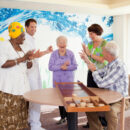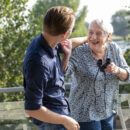What Is Sundown Syndrome In the Elderly?
Discover how to effectively manage sundown syndrome in elderly loved ones with dementia. Learn about the symptoms, causes, and proven strategies to create a more peaceful and supportive environment. Read on to explore expert insights and practical tips.

Sundown syndrome is a common condition that affects many elderly individuals, particularly those with dementia. As evening approaches, they may experience a noticeable increase in confusion, anxiety, and agitation. These late-day symptoms can be challenging for both the individual and their caregivers, making the evenings particularly stressful.
Early recognition of sundown syndrome is essential for effectively managing this condition. By identifying the signs early, caregivers can implement strategies that help minimize symptoms, such as maintaining a consistent routine, adjusting lighting, and creating a calm environment. Understanding the triggers, like changes in light levels or overstimulation, can also help caregivers take proactive steps to support their loved ones. This article from Koelsch Communities provides practical advice and insights into managing sundown syndrome, with the goal of helping your loved ones feel more secure and comfortable during these vulnerable hours of the day.
What Is Sundowners in Elderly Adults?
Definition and Overview
Sundown syndrome, also known as sun setting syndrome or sundowners, refers to a condition where elderly individuals, particularly those with dementia, experience heightened confusion, anxiety, and agitation during the late afternoon or evening. As the sun sets and natural light diminishes, many affected individuals begin to struggle with recognizing familiar surroundings, following conversations, or understanding their environment. This confusion can trigger a range of behaviors, including restlessness, wandering, and even mood swings, making these evening hours particularly difficult.
Sundown syndrome typically manifests in the middle to later stages of dementia, when the brain’s ability to process changes in light and routine becomes compromised. Caregivers may observe that symptoms intensify as daylight fades, creating a sense of unpredictability and distress. By recognizing the signs of sundown syndrome early, caregivers can take steps to manage these symptoms, helping to create a more comforting and stable environment for their loved ones.
What Are the Symptoms of Sun Setting Syndrome?
Behavioral and Psychological Symptoms
Sundown syndrome often involves a combination of behavioral and psychological symptoms, which typically worsen in the late afternoon and evening. Confusion is one of the most common signs. As the day progresses, individuals may have difficulty recognizing their surroundings or familiar faces, which leads to disorientation and a heightened sense of fear. This confusion can quickly turn into anxiety, causing the person to become increasingly distressed. They might pace, express worries that seem irrational, or repeatedly ask the same questions in an anxious tone.
Agitation often follows, with the individual becoming irritable, raising their voice, or resisting attempts to assist them. Restlessness is also a frequent symptom; they may feel an uncontrollable urge to move, making it hard to settle down for the night. Some may even wander, which can increase the risk of accidents. Recognizing these symptoms early allows for timely interventions that can help manage their effects and create a more calming environment.
Sundown syndrome can be overwhelming, but understanding the triggers and symptoms is the first step toward effective management. By creating a calm and structured environment, you can significantly reduce the distress your loved one experiences in the late afternoon and evening hours.
What Causes Sundown Syndrome in the Elderly?
The Role of Dementia in Sundowning
Dementia significantly contributes to the development of sundown syndrome. As dementia progresses, the brain’s ability to regulate the sleep-wake cycle deteriorates. This disruption often leads to confusion and disorientation as daylight fades. The brain struggles to process changes in the environment, such as the shift from daylight to evening, resulting in increased anxiety and agitation during these hours.
Environmental and External Triggers
Environmental factors also play a role in sundowning. Changes in lighting, such as dimming natural light in the evening, can trigger confusion. Disruptions in daily routines, like a sudden change in activities, can heighten anxiety. Overstimulation from noise, crowds, or even too much activity can overwhelm individuals with dementia, worsening their symptoms. Seasonal changes, particularly shorter days in winter, may also intensify sundowning, as the earlier onset of darkness can confuse the internal clock further.
What Stage of Dementia Is Sundowning?
Understanding the Progression of Dementia
Dementia progresses through distinct stages, beginning with mild memory loss and advancing to severe cognitive and physical impairment. Sundowning usually emerges during the middle stages, when the brain’s ability to regulate the internal clock—the circadian rhythm—begins to deteriorate. This disruption leads to confusion, anxiety, and agitation, especially as daylight fades.
As dementia moves into the later stages, sundowning can become more pronounced, with symptoms intensifying and occurring more frequently. The appearance of sundowning behaviors can be an indicator that dementia is progressing, signaling the need for adjustments in care. Recognizing this progression allows caregivers to implement strategies like adjusting daily routines, improving lighting in the evening, and incorporating calming activities to help manage symptoms. Early intervention can significantly improve the individual’s comfort and reduce the stress associated with these behaviors, providing a better quality of life for both the individual and their caregivers.
How Do You Stop Sundowning in the Elderly?
Effective Management and Prevention Strategies
Creating a calm environment is essential. Reduce noise, dim harsh lights, and keep the surroundings familiar. Stick to a consistent daily routine with regular times for meals, activities, and rest. Predictability helps reduce anxiety. Identify and minimize triggers, such as large gatherings or changes in surroundings, that might upset your loved one.
Caregivers play a vital role in managing sundown syndrome. They can observe patterns in behavior and adjust routines accordingly. Simple actions, like speaking in a soothing tone or offering gentle reassurances, can make a significant difference.
Non-Pharmacological Approaches
Several non-drug therapies can ease symptoms. Light therapy in the morning can help regulate the sleep-wake cycle. Music therapy can create a soothing atmosphere, while relaxation exercises, such as deep breathing, can calm agitation. Personalizing these approaches based on individual preferences and needs ensures they are more effective for enhancing comfort and well-being.
Which Items Should Be Avoided to Help Reduce Sundowning?
Dietary and Environmental Considerations
Certain foods, beverages, and medications can worsen sundowning symptoms. Caffeine, found in coffee, tea, and some sodas, can increase restlessness if consumed late in the day. Sugary snacks and desserts can cause energy spikes followed by crashes, leading to irritability and agitation. Heavy meals close to bedtime may also disrupt sleep, making sundowning symptoms worse.
Overstimulation from noise, clutter, or crowds can overwhelm those with dementia. Loud environments, too many visitors at once, or even a room filled with too many objects can heighten anxiety and confusion. To help, create a quiet, organized space where your loved one can feel safe and calm, especially as the day draws to a close. Reducing these triggers can significantly ease the evening hours and help your loved one experience a more peaceful night.
The Importance of Caregiver Support
Strategies for Caregivers to Manage Stress
Caring for someone with sundown syndrome can be exhausting, both physically and emotionally. To manage stress effectively, start by establishing a daily routine that balances caregiving tasks with moments of rest. Short breaks throughout the day can help you recharge, even if it’s just a few minutes of deep breathing or a quick walk outside.
Connecting with others who understand your challenges is also vital. Join a local or online support group where you can share experiences and gain advice from those in similar situations. These communities offer valuable insights and emotional support, reminding you that you’re not alone.
If you need a longer break, don’t hesitate to seek respite care. Temporary relief allows you to step back and focus on your well-being, which ultimately benefits both you and your loved one. Prioritizing your health enables you to continue providing the best care possible.
The Role of Professional Healthcare in Managing Sundown Syndrome
When to Seek Medical Advice
If your loved one’s sundown syndrome symptoms become increasingly severe or difficult to manage, it’s important to seek medical advice. Signs that professional intervention may be necessary include escalating agitation, aggression, or behaviors that put your loved one or others at risk. Additionally, if you’ve tried routine adjustments, environmental changes, or non-pharmacological approaches without seeing improvement, it’s time to consult a healthcare provider.
Healthcare professionals can offer more specialized interventions. They might evaluate current medications to identify those that could be worsening symptoms and adjust dosages or prescriptions accordingly. They may also suggest therapies such as cognitive-behavioral techniques or other targeted treatments that can address the specific needs of your loved one. Collaborating with a healthcare provider allows for the development of a tailored care plan that not only addresses immediate symptoms but also supports long-term well-being, ensuring your loved one receives the best possible care.
Closing Thoughts
Understanding sundown syndrome is essential for providing effective care. Recognizing the symptoms early can help prevent them from escalating into more serious issues. This condition often presents as increased confusion, anxiety, or agitation during the late afternoon and evening. By identifying these signs, you can begin to address the underlying causes and triggers.
Tailoring care to each individual’s needs plays a key role in managing sundown syndrome. Establishing consistent routines, creating a calm environment, and using therapies like light and music can significantly improve quality of life. Early intervention not only reduces stress for those affected but also supports caregivers in their roles.
Taking the time to understand sundown syndrome and adopting personalized strategies makes a meaningful difference in the well-being of your loved ones. By staying informed and proactive, you can help them navigate these challenging moments with greater ease.
About Koelsch Communities
Koelsch Communities offers a wide range of “Mom-approved” senior living options designed to create fulfilling and enjoyable experiences. With over 60 years of experience, we have built a reputation for providing top-quality care and exceptional living environments. Our communities are staffed by professionals dedicated to treating our Ladies and Gentlemen with respect and providing the special attention they need.
We pride ourselves on our high customer satisfaction, which reflects our commitment to excellence. Our experienced team ensures that every resident feels valued and cared for, promoting a thriving and supportive community atmosphere.
For more information about our senior living options and to discover how we can help you or your loved one enjoy the finest living experiences, please contact us today. We look forward to welcoming you to our community and helping you find the perfect senior living solution.
Disclaimer: This article is for informational purposes only and does not constitute medical, legal, or financial advice. It’s recommended to consult with a medical, legal, or financial professional for your specific circumstances.









